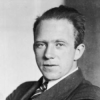Werner Heisenberg

Werner Heisenberg
Werner Karl Heisenbergwas a German theoretical physicist and one of the key pioneers of quantum mechanics. He published his work in 1925 in a breakthrough paper. In the subsequent series of papers with Max Born and Pascual Jordan, during the same year, this matrix formulation of quantum mechanics was substantially elaborated. In 1927 he published his uncertainty principle, upon which he built his philosophy and for which he is best known. Heisenberg was awarded the Nobel Prize in Physics for...
NationalityGerman
ProfessionScientist
Date of Birth5 December 1901
CityWurzburg, Germany
CountryGermany
If nature leads us to mathematical forms of great simplicity and beauty—by forms, I am referring to coherent systems of hypotheses, axioms, etc.—to forms that no one has previously encountered, we cannot help thinking that they are “true,” that they reveal a genuine feature of nature…. You must have felt this too: the almost frightening simplicity and wholeness of the relationships which nature suddenly spreads out before us and for which none of us was in the least prepared.
It was about three o'clock at night when the final result of the calculation [which gave birth to quantum mechanics] lay before me ... At first I was deeply shaken ... I was so excited that I could not think of sleep. So I left the house ... and awaited the sunrise on top of a rock.
I think that the discovery of antimatter was perhaps the biggest jump of all the big jumps in physics in our century.
I think that modern physics has definitely decided in favor of Plato. In fact the smallest units of matter are not physical objects in the ordinary sense; they are forms, ideas which can be expressed unambiguously only in mathematical language.
It is probably true quite generally that in the history of human thinking the most fruitful developments frequently take place at those points where two different lines of thought meet. These lines may have their roots in quite different parts of human nature, in different times or different cultural environments or different religious traditions: hence if they actually meet, that is, if they are at least so much related to each other that a real interaction can take place, then one may hope that new and interesting developments may follow.
Not only is the Universe stranger than we think, it is stranger than we can think.
The first gulp from the glass of natural sciences will turn you into an atheist, but at the bottom of the glass God is waiting for you.
The solution of the difficulty is that the two mental pictures which experiment lead us to form - the one of the particles, the other of the waves - are both incomplete and have only the validity of analogies which are accurate only in limiting cases.
It seems sensible to discard all hope of observing hitherto unobservable quantities, such as the position and period of the electron... Instead it seems more reasonable to try to establish a theoretical quantum mechanics, analogous to classical mechanics, but in which only relations between observable quantities occur.
A consistent pursuit of classical physics forces a transformation in the very heart of that physics.
Every word or concept, clear as it may seem to be, has only a limited range of applicability.
Natural science, does not simply describe and explain nature; it is part of the interplay between nature and ourselves
The discontinuous 'reduction of the wave packets' which cannot be derived from Schroedinger's equation is ... a consequence of the transition from the possible to the actual.
In my paper the fact the XY was not equal to YX was very disagreeable to me. I felt this was the only point of difficulty in the whole scheme...and I was not able to solve it.